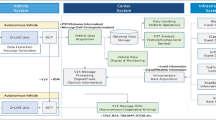Abstract
Autonomous driving algorithms are always in operation during normal driving and require responses to many more driving situations than ADAS, which assists the driver only in specific risk scenarios. However, due to the absence of a quantitative algorithm evaluation method, most algorithms are evaluated in their own test scenarios. Even in similar cases in identical scenarios, different decisions may be made depending on small differences such as the speed or location of surrounding vehicles. Therefore, one representative scenario cannot cover all cases and it is difficult to quantitatively compare and evaluate algorithms. In this study, the parameters constituting the scenario are determined for lane change and intersection scenarios, typical scenarios in autonomous driving research. Then, all key parameters are swept within a certain range, and all cases that are slightly different are generated even in identical scenario. Simulations are performed automatically on the generated cases, and the vehicle risk is calculated on all cases based on the time to occupancy (TTO). Using this evaluation method, edge cases in which the autonomous algorithm may have weaknesses can be found.
Similar content being viewed by others
Abbreviations
- a y :
-
lateral acceleration, m/s2
- L :
-
driving distance, m
- l w :
-
line width, m
- P :
-
vehicle position
- P activation :
-
activation point, x
- P collision :
-
collision point, x
- P start :
-
start position, x
- P lc :
-
lane change position, x
- S collision :
-
scenario execution driving distance, m
- S shift :
-
collision point shift, m
- t y :
-
cut-in execution time, sec
- V :
-
vehicle speed, m/s
- ego:
-
ego vehicle
- sur:
-
surrounding vehicle
- cut:
-
cut-in maneuver
- rel:
-
relative (position, speed)
References
Bae, J. J., Lee, M. S. and Kang, N. (2020). Partial and full braking algorithm according to time-to-collision for both safety and ride comfort in an autonomous vehicle. Int. J. Automotive Technology 21, 2, 351–360.
Funke, J., Brown, M., Erlien, S. M. and Gerdes, J. C. (2016). Collision avoidance and stabilization for autonomous vehicles in emergency scenarios. IEEE Trans. Control Systems Technology 25, 4, 1204–1216.
Gelbal, S. Y., Aksun-Guvenc, B. and Guvenc, L. (2020). Collision avoidance of low speed autonomous shuttles with pedestrians. Int. J. Automotive Technology 21, 4, 903–917.
Hwang, S., Lee, K., Jeon, H. and Kum, D. (2022). Autonomous vehicle cut-in algorithm for lane-merging scenarios via policy-based reinforcement learning nested within finite-state machine. IEEE Trans. Intelligent Transportation Systems, 1–13.
Isermann, R., Schorn, M. and Stählin, U. (2008). Anticollision system PRORETA with automatic braking and steering. Vehicle System Dynamics 46, S1, 683–694.
Jeon, H. S., Kum, D. S. and Jeong, W. Y. (2018). Traffic scene prediction via deep learning: Introduction of multichannel occupancy grid map as a scene representation. IEEE Intelligent Vehicles Symposium (IV), Suzhou, China.
Jeon, S., Lee, K. and Kum, D. (2022). Overtaking decision and trajectory planning in highway via hierarchical architecture of conditional state machine and chance constrained model predictive control. Robotics and Autonomous Systems, 104014.
Ji, J., Khajepour, A., Melek, W. W. and Huang, Y. (2016). Path planning and tracking for vehicle collision avoidance based on model predictive control with multiconstraints. IEEE Trans. Vehicular Technology 66, 2, 952–964.
Kim, H., Shin, K., Chang, I. and Huh, K. (2018). Autonomous emergency braking considering road slope and friction coefficient. Int. J. Automotive Technology 19, 6, 1013–1022.
Kim, J. and Kum, D. (2017). Collision risk assessment algorithm via lane-based probabilistic motion prediction of surrounding vehicles. IEEE Trans. Intelligent Transportation Systems 19, 9, 2965–2976.
Lee, J., Jung, U. and Song, B. (2020). Critical scenario generation for collision avoidance of automated vehicles based on traffic accident analysis and machine learning. Trans. KSAE 28, 11, 817–826.
Lee, K. and Kum, D. (2019). Collision avoidance/mitigation system: Motion planning of autonomous vehicle via predictive occupancy map. IEEE Access, 7, 52846–52857.
Nam, H., Choi, W. and Ahn, C. (2019). Model predictive control for evasive steering of an autonomous vehicle. Int. J. Automotive Technology 20, 5, 1033–1042.
Park, C., Jeong, N. T., Yu, D. and Hwang, S. H. (2019). Path generation algorithm based on crash point prediction for lane changing of autonomous vehicles. Int. J. Automotive Technology 20, 3, 507–519.
Shim, T., Adireddy, G. and Yuan, H. (2012). Autonomous vehicle collision avoidance system using path planning and model-predictive-control-based active front steering and wheel torque control. Proc. Institution of Mechanical Engineers, Part D: J. Automobile Engineering 226, 6, 767–778.
Yoon, S., Jeon, H. and Kum, D. (2019). Predictive cruise control using radial basis function network-based vehicle motion prediction and chance constrained model predictive control. IEEE Trans. Intelligent Transportation Systems 20, 10, 3832–3843.
Zhang, Y., Chen, H., Waslander, S. L., Gong, J., Xiong, G., Yang, T., and Liu, K. (2018). Hybrid trajectory planning for autonomous driving in highly constrained environments. IEEE Access, 6, 32800–32819.
Acknowledgement
This work was supported by the National Research Foundation of Korea (NRF) grant funded by the Korea government (MSIT) (No. 2020R1F1A1068376) and the Technology Innovation Program (No. 20019115) funded by the Ministry of Trade, Industry & Energy (MOTIE, Korea).
Author information
Authors and Affiliations
Corresponding author
Additional information
Publisher’s Note
Springer Nature remains neutral with regard to jurisdictional claims in published maps and institutional affiliations.
Rights and permissions
About this article
Cite this article
Jung, J., Lee, K. Automatic Scenario Generation for Decision Algorithm Performance Evaluation of Autonomous Vehicle via Scenario Parameter Sweeping Method. Int.J Automot. Technol. 23, 1383–1391 (2022). https://doi.org/10.1007/s12239-022-0121-z
Received:
Revised:
Accepted:
Published:
Issue Date:
DOI: https://doi.org/10.1007/s12239-022-0121-z




